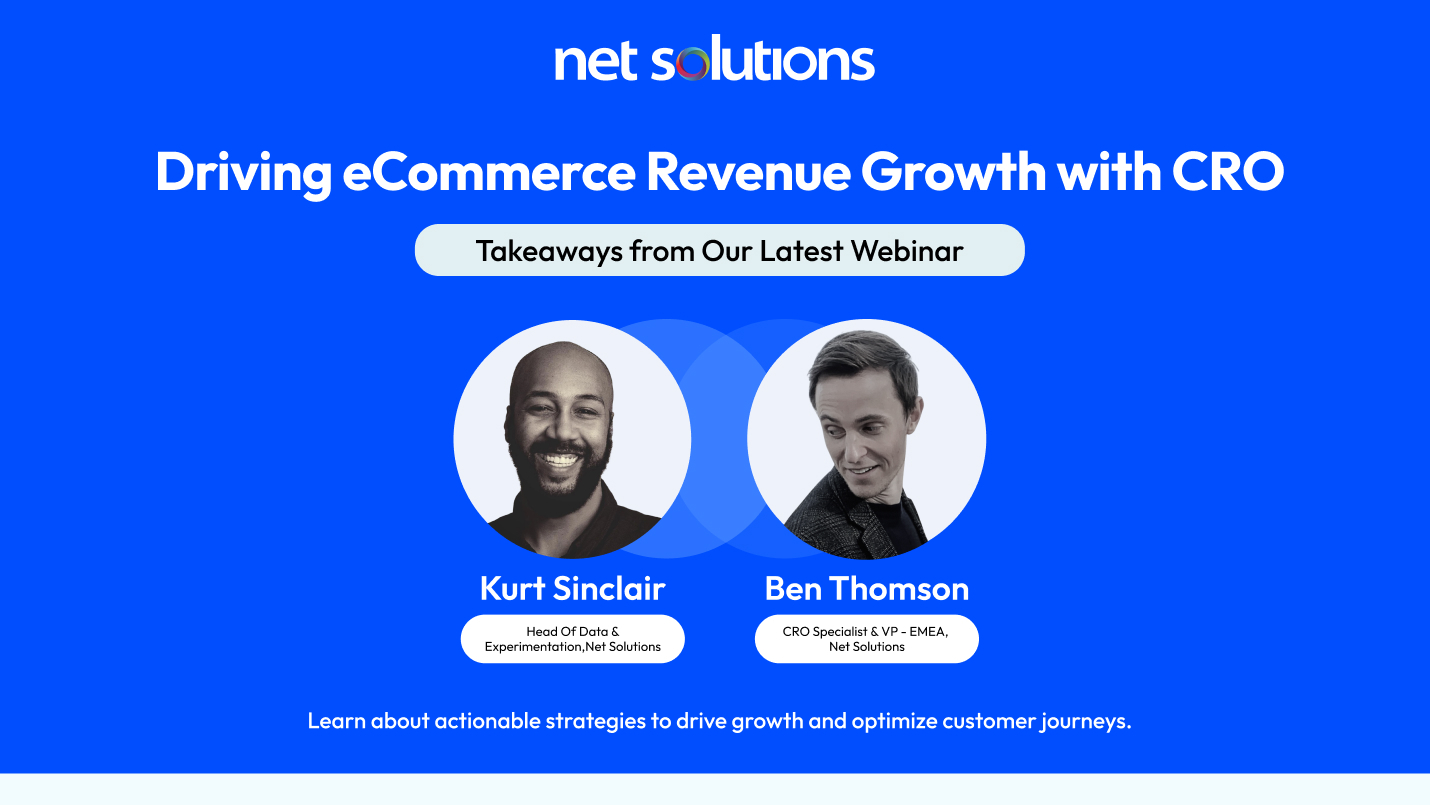Conversion Rate Optimization (CRO) is a game-changer for eCommerce growth, yet many businesses struggle with the right approach. This blog showcases the conversation from our latest webinar on the same topic.
Ben and Kurt from Net Solutions share their expertise on how CRO, when driven by data and core metrics like average revenue per user (ARPU), can significantly boost revenue. Through real-world examples, they demonstrate how understanding customer behavior, optimizing traffic sources, and prioritizing high-revenue channels can drive exponential growth.
The insights provide a clear roadmap for improving conversion outcomes and revenue performance.
Read on to know more.
Introduction to Net Solutions and Our Focus on CRO
Ben: Hi, everyone. I’m Ben, and I head up the team here at Net Solutions. I’m joined today by Kurt, who I’ll introduce in just a moment. Net Solutions is an agency specializing in three key areas—eCommerce, digital transformation, and product development. Over the past year, we’ve gained some recognition for our work in conversion rate optimization (CRO). Today, we’re going to share some insights into how we achieved success in CRO throughout 2024 and how we’re continuing that into this year.
The focus of today’s conversation is “Driving eCommerce Growth Revenue Through CRO: Turning Customer Behavior Into Growth.” As I mentioned, I’m joined by Kurt. Kurt, do you want to introduce yourself?
Kurt Sinclair: Yeah. Hi, everyone. I’m Kurt Sinclair, Head of Data and Experimentation at Net Solutions. I’ve spent the last decade in the CRO space across different scopes—global agencies, boutique agencies, in-house consulting, and enterprise-level engagements.
I’ve seen both good and bad CRO practices, and today, I’m here to show you some of what good CRO looks like—and how you can apply these insights to your business.
The Fundamental Problem: Businesses Lack Key Insights Into Customer Behavior
Ben: Thanks, Kurt. I want to start by highlighting something we shared at an industry event last November: 99% of organizations lack key insights into customer behavior. But what do we mean by that? We mean that most businesses focus too much on average order value (AOV) rather than average revenue per user (ARPU). Let me flip that around with a question for you—there’s no need to answer, but feel free to if you’d like.
Do you know the revenue or conversion difference between a product display page (PDP) with 5 images versus one with 10?
These are the types of questions businesses need to be asking to understand customer behavior at a granular level. Focusing on ARPU instead of just AOV allows you to optimize your site and direct marketing spend toward the highest-value customers. For example, would you rather have 100 conversions at $1 each, or 10 conversions at $10,000 each?
This high-level approach has driven our success throughout 2024, and if anyone is unfamiliar with our results—we achieved a 100% success rate last year.
Understanding Core Metrics: Why ARPU Matters
Ben: Now, I’m going to pass things over to Kurt, who will walk you through.
Kurt Sinclair: Thanks, Ben.
One of the biggest sources of confusion in CRO is which metrics to focus on—and how to extract real value from them. We’re going to walk through three core areas:
- Choosing the right metrics: Core metrics shape how quickly you can understand and act, and investing in data structures today improves decision-making tomorrow.
- Communicating value across teams: Revenue grows when functions chase the same goal, meaning that alignment across teams is critical.
- Building data structures that drive better decisions: Lastly, free analytics tools like Google Analytics (GA) pose significant risks to multi-million-dollar operations. If you’re doing over $10 million annually online, you should strongly consider using paid analytics tools instead of relying on GA’s limited insights.
A lot of companies get stuck thinking CRO is just about optimizing conversion rates or AOV, but that’s an oversimplification. We need to separate concerns when looking at performance.
For example, session-based conversion rates are misleading because they mix buying intent with research time. Instead, we advocate using ARPU—a metric that combines both volume and value.
Most people don’t realize that ARPU can be calculated in two ways:
Total Revenue ÷ Total Users (SaaS approach)
User Conversion Rate × AOV (eCommerce approach)
Why does this matter? Because it allows businesses to see whether changes in revenue are driven by more users converting or by higher order values. It also simplifies conversations about performance. Instead of debating “Is 2.7% conversion at $180 AOV better than 2.3% at $217?”, we can compare $5 per user to $4.86 per user.
This is one of the most underutilized yet powerful metrics in eCommerce.
How Data Structures Influence CRO Strategy
Kurt Sinclair: Most businesses focus too much on behavioral data (e.g., “How many users clicked Add to Cart?”). While that’s important, what’s more valuable is strategic context.
For example:
- How does price elasticity impact sales?
- Are high-value users browsing multiple PDPs before converting?
When we analyze CRO for a client, we start by mapping revenue flows and identifying inefficiencies in traffic sources.
Here’s an example:
- Paid social traffic generates $1.10 ARPU.
- Paid search traffic generates $16.80 ARPU.
- That’s a $15 million difference per 1 million users.
Where should you invest more? The answer is clear.
Optimizing for Devices: Mobile vs. Desktop Strategy
A common debate in eCommerce is whether to prioritize mobile or desktop. Most retailers think they should optimize for mobile because 80% of their traffic comes from mobile users.
However, when we look at revenue contribution, we often see the opposite:
Mobile users generate $2 ARPU.
Desktop users generate $36 ARPU.
So, which should be prioritized? Revenue.
A 10% increase in desktop conversion can be worth millions while improving mobile conversion might have a smaller impact.
Ben: We hope this webinar has given you insights into what real CRO looks like—beyond just UX tweaks.
As a thank-you, we’re offering a free audit.
This audit will:
- ✅ Identify your ARPU and traffic inefficiencies
- ✅ Highlight tagging gaps and missing data
- ✅ Show who your website was actually built for
Thanks for joining us—this has been CRO as it should be. Not just UX but data-driven revenue growth.



